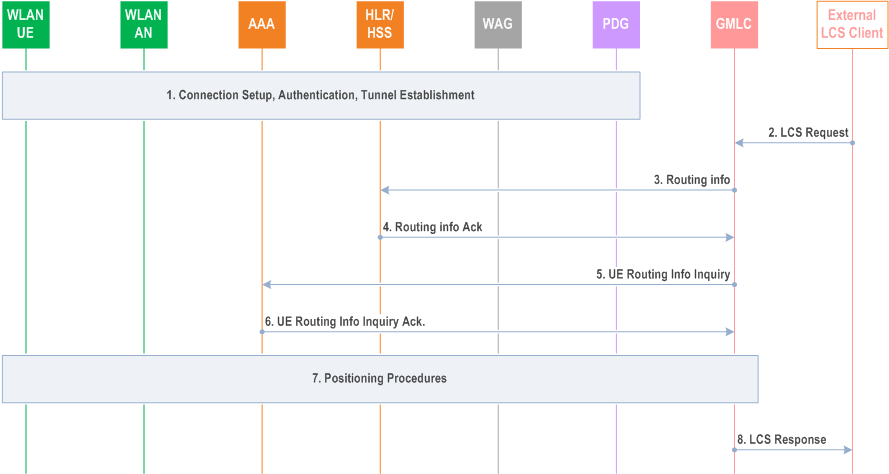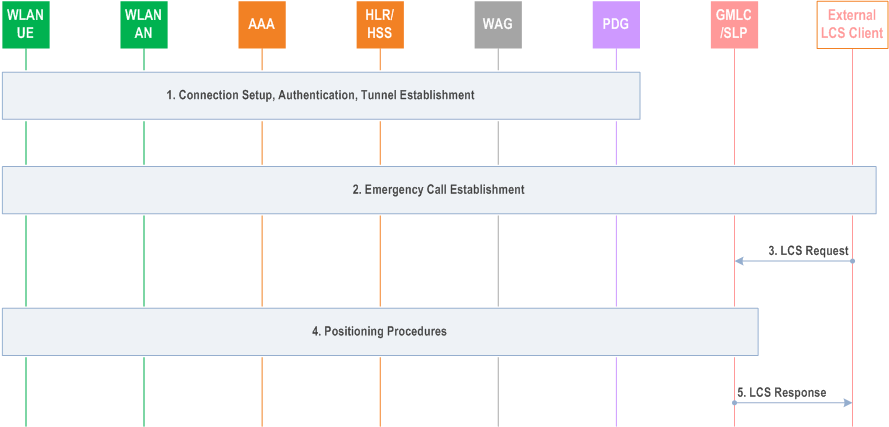Content for TS 23.271 Word version: 18.0.0
1…
5…
6…
6.2…
7…
8…
9…
9.1.1A…
9.1.2…
9.1.5…
9.1.6…
9.1.8…
9.1.9…
9.1.12…
9.1.13…
9.1.15…
9.1.19…
9.2…
9.2.2…
9.2.3…
9.3…
9.4…
9.5…
9.6…
10…
11…
A…
B…
E
F…
9.1.13 IW-MT-LR Procedure |R7| p. 105
Figure 9.16 describes the IW-MT-LR procedure. This procedure is applicable to the I-WLAN defined in TS 23.234 and it is no longer maintained.

Step 1.
A WLAN UE selects a WLAN AN and establishes the WLAN connection and is authenticated in I-WLAN. The WLAN AN may send the current location of WLAN AN to the WLAN UE. The WLAN AN may send its location to the AAA. The tunnel may be established with between WLAN UE and one of PDGs in PLMN.
Step 2.
An external LCS client sends the LCS request to the GMLC. An external LCS client requests the current location, e.g. immediate location request, from a GMLC. The LCS Client may also request a triggered location request, e.g. periodic or change of area event. The GMLC verifies the identity of the LCS client and its subscription to the LCS service requested and derives the MSISDN or IMSI or pseudonym of the target UE to be located and the LCS QoS from either subscription data or data supplied by the LCS client.
The LCS request may carry also the Service Identity and the Codeword. The GMLC may verify that the Service Identity received in the LCS request matches one of the service identities allowed for the LCS client. If the service identity does not match one of the service identities for the LCS client, the GMLC shall reject the LCS request. Otherwise, the GMLC can map the received service identity in a corresponding service type.
If the location request is originated by a Requestor, the Requestor Identity may be added to the LCS service request. The LCS client should authenticate the Requestor Identity but this is outside the scope of this specification. The LCS service request may also contain the type of the Requestor identity if the requestor identity was included.
The GMLC performs privacy check on the basis of the UE user's privacy profile stored in the GMLC or PPR.
Step 3.
Steps 3 and 4 may be skipped if the GMLC already has the address of the AAA server. Steps 3 to 6 may be skipped if the GMLC has alternative access to the UE's IP address (e.g. using dynamic DNS or from a previous interaction with the UE) or is able to instigate step 7 without knowing this address (e.g. using MT-SMS or WAP Push in the case of SUPL). GMLC requests the address of AAA server and WLAN UE capability to the HSS. In this case, the capability information of the WLAN UE refers to capability information of the terminal relevant to positioning such as whether the terminal supports the OMA SUPL (OMA AD SUPL [38], OMA TS ULP [39]) or whether it supports another location procedures.
Step 4.
HSS returns the address of AAA server of the target WLAN UE and the capability of the WLAN UE to GMLC.
Step 5.
If the target WLAN UE supports the OMA SUPL, GMLC queries AAA to obtain the address of WLAN UE. GMLC may request the location of WLAN UE.
Step 6.
If its location is available and the quality of position meets the LCS QoS requested by GMLC, then AAA responds with available location information of the WLAN UE to the GMLC. Otherwise, GMLC retrieves the address of WLAN UE from AAA. If there is no tunnel is available between the PDG and the WLAN UE, the AAA will return an indication that UE is not reachable.
Step 7.
GMLC initiates positioning procedure. This shall use SUPL procedures based on OMA SUPL (OMA AD SUPL [38], OMA TS ULP [39]). If the tunnel between the WLAN UE and the PDG is available and the GMLC has obtained the UE IP address, GMLC generates an SUPL initiation message, and transmits it to the WLAN UE by using the address of WLAN UE over available IP connection between the WLAN UE and the PDG. If the tunnel between the WLAN UE and the PDG is not available or if the GMLC did not obtain the UE IP address, GMLC sends an SUPL initiation message using the UE IP address if available or by other means (e.g. MT-SMS or WAP Push).
Step 8.
The location information obtained will be transferred to external LCS client.
9.1.14 IW-MT-LR Procedure without HLR/HSS or AAA Query |R7| p. 106
This procedure is applicable to the I-WLAN defined in TS 23.234 and it is no longer maintained.
Figure 9.17 illustrates current or last known location requests for an emergency services call, where an emergency services client (i.e. a Public Safety Answering Point) requests updated location information for the target UE. In order to support location of emergency call s from UICC-less terminals, TS 23.167 specifies that the IMS core shall push information identifying the terminal to the PSAP and GMLC during establishment of the emergency call.
The IMS core also sends the correlation information to the PSAP during the call establishment as described in TS 23.167. Using the correlation key the PSAP may request the initial or updated location information from the GMLC. The management of this regional correlation information (e.g. ESQK in North America) and support of the Le interface to the external LCS Client may be handled by a separate functional entity from the GMLC, e.g. a RDF as defined in TS 23.167.

Step 1.
The WLAN UE selects a WLAN AN and establishes the WLAN connection and may be authenticated in I-WLAN. The tunnel is established between the WLAN UE and a PDG in PLMN.
Step 2.
The WLAN UE establishes an emergency services call as described in TS 23.167. The UE determines its own location if possible. The UE may include the identifier of access node (e.g., MAC address of the AP), if available, as location identifier in the session request and possibly other readily available location information, e.g. GPS based coordinates or the street address of the UE or the AP as provided by the user of the UE. If the UE is not able to determine its own location, the UE may, if capable, request the location information from the IP CAN or SLP. The case when the UE requests its own location information or enhanced location information from the SLP using OMA-SUPL is described in clause 9.2.5. The IP-CAN may return a representation of the location information to the UE. During this step, the IMS core may push the WLAN UE's identification and the location information provided by the UE to the LRF (GMLC) along with correlation information, if applicable. The GMLC may record this information but in some regions only for the duration of the call as the case may be. The correlation information may be regionally specific (e.g. as is the case for support of location for an emergency call in the CS domain in clause 9.1.3). The IMS core shall also send the correlation information to the PSAP/ emergency centre during the call establishment as specified in TS 23.167.
Step 3.
An external LCS client associated with the emergency centre PSAP sends a location request to the GMLC for the initial location or an updated location for the WLAN UE. The request may include the address and the identification of the WLAN UE and in some regions may include correlation information that enables the GMLC to associate the request with the information stored in step 2.
Step 4.
If initial location was requested the procedure continues from step 5. If updated location was requested the GMLC initiates a positioning procedure where either the UE or GMLC determines the position of the UE. GMLC/SLP shall request the UE to establish a so called user plane connection with the GMLC/SLP and use the OMA SUPL mechanism specified by OMA (OMA AD SUPL [38], OMA TS ULP [39]) to transport location related assistance data and location information between the UE and GMLC/SLP. The UE may send the identifier of the access node (e.g. MAC address of the AP) to the GMLC and GMLC, possibly using an external database, maps this location identifier to the corresponding geographical information, e.g. coordinates or street address. GMLC may return this geographical information to the UE.
Step 5.
GMLC sends the initial location information, if so requested, or the updated location information obtained in step 4 to the external LCS client.